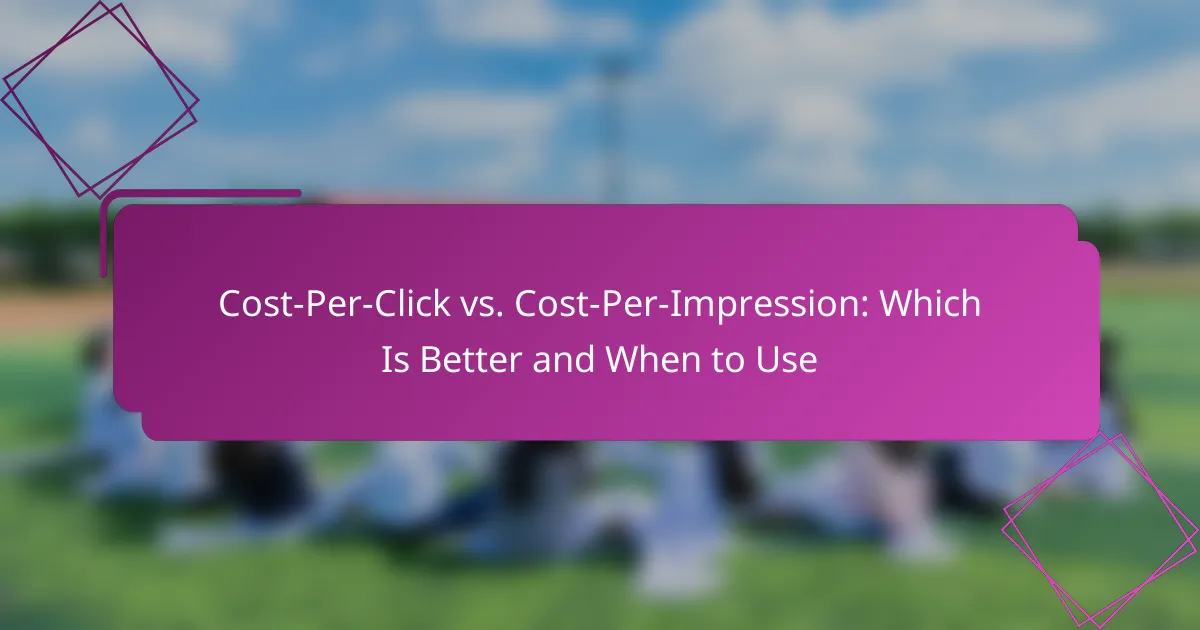Understanding the difference between Cost-Per-Click (CPC) and Cost-Per-Impression (CPI) is crucial for optimizing your advertising strategy. CPC is ideal for driving traffic and generating leads, as advertisers only pay when users click on their ads. In contrast, CPI focuses on brand visibility, charging advertisers for each impression their ad receives, regardless of user interaction. Choosing the right model depends on your campaign goals and desired outcomes.

What is Cost-Per-Click (CPC) in display advertising?
Cost-Per-Click (CPC) is a pricing model in display advertising where advertisers pay a fee each time a user clicks on their ad. This approach allows marketers to only incur costs when their ads generate actual traffic to their website, making it a performance-based strategy.
Definition of Cost-Per-Click
Cost-Per-Click refers to the amount an advertiser pays for each click on their advertisement. This model is commonly used in online advertising platforms like Google Ads, where the cost can vary based on competition, ad quality, and targeting options. Advertisers typically set a maximum bid for how much they are willing to pay for each click.
How CPC works in campaigns
CPC works by allowing advertisers to bid on keywords or placements relevant to their target audience. When a user clicks on the ad, the advertiser is charged the agreed-upon CPC amount. The actual cost can be lower than the maximum bid, depending on the competition for the ad space and the ad’s quality score.
To optimize CPC campaigns, advertisers should focus on creating high-quality ads that resonate with their audience. Regularly monitoring performance metrics, such as click-through rates and conversion rates, can help in adjusting bids and improving overall campaign effectiveness. Avoiding overly broad targeting can also help in managing costs effectively.
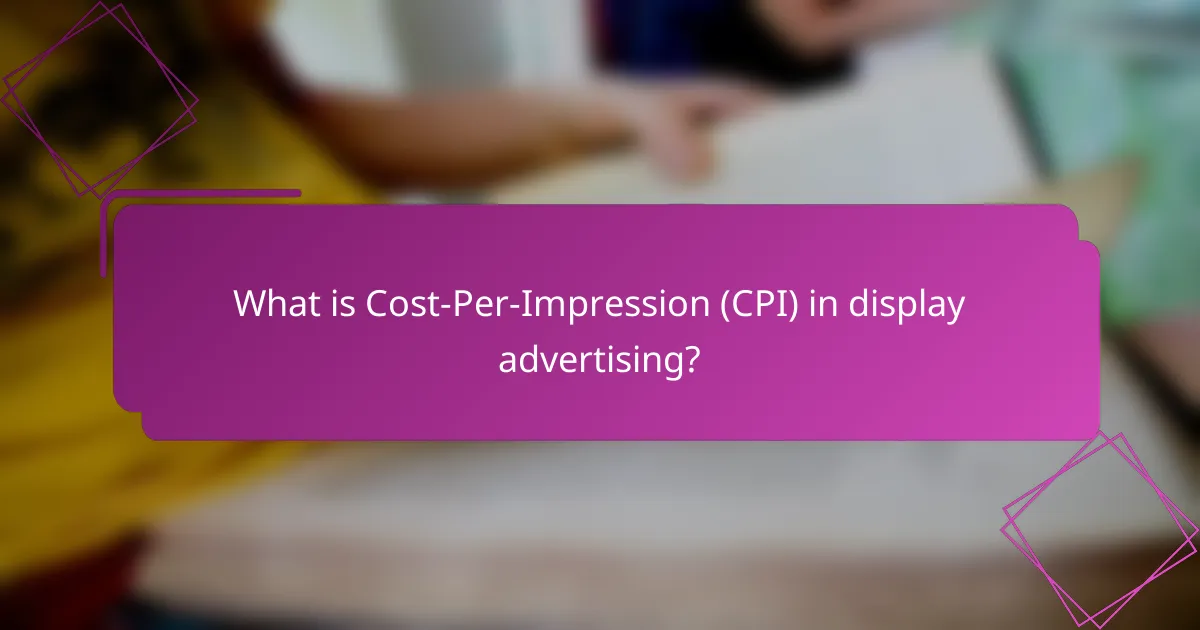
What is Cost-Per-Impression (CPI) in display advertising?
Cost-Per-Impression (CPI) is a pricing model in display advertising where advertisers pay for each time their ad is shown, regardless of whether it is clicked. This model is particularly useful for brand awareness campaigns, as it focuses on maximizing visibility rather than immediate engagement.
Definition of Cost-Per-Impression
Cost-Per-Impression refers to the cost incurred by advertisers for every thousand impressions their ad receives, often expressed as CPM (Cost Per Mille). This metric helps advertisers gauge the effectiveness of their ad placements in reaching a broad audience.
In contrast to Cost-Per-Click (CPC), where payment is based on user interaction, CPI emphasizes the number of times an ad is displayed. This model is beneficial for campaigns aiming to enhance brand visibility rather than drive direct responses.
How CPI works in campaigns
CPI operates by charging advertisers a set fee for every thousand impressions their ads generate. Advertisers typically set a budget and bid for ad placements based on their target audience and desired reach. The higher the bid, the more likely the ad will be displayed on premium sites.
To effectively use CPI in campaigns, advertisers should identify their target demographics and choose platforms that align with their audience. Monitoring metrics such as reach and frequency can help optimize campaigns and ensure that the ad is seen by the intended viewers.
Common pitfalls include overestimating the effectiveness of impressions without considering engagement metrics. Advertisers should balance CPI with other models like CPC to achieve comprehensive campaign goals, especially when measuring success through conversions or interactions.
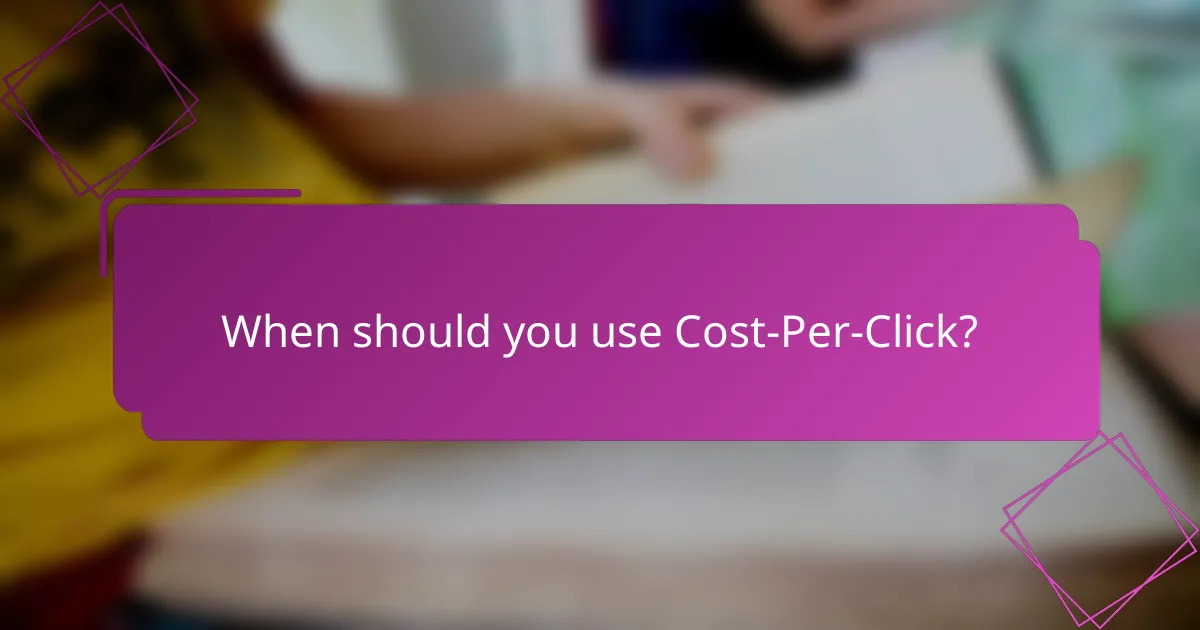
When should you use Cost-Per-Click?
Cost-Per-Click (CPC) is best used when your primary goal is to drive traffic to your website and generate leads or sales. This model allows you to pay only when someone clicks on your ad, making it a cost-effective choice for campaigns focused on immediate user engagement.
Best scenarios for CPC usage
CPC is particularly effective for businesses with clear conversion goals, such as e-commerce sites looking to sell products directly. It works well in competitive markets where attracting clicks can lead to higher sales volumes. For example, if your average conversion rate is around 2-5%, investing in CPC can yield a positive return on investment if the cost per click is low compared to the profit margin on sales.
Additionally, CPC is suitable for time-sensitive promotions or events. If you’re launching a new product or running a limited-time offer, using CPC can help you quickly attract potential customers and drive immediate action.
Target audience considerations for CPC
Understanding your target audience is crucial when using CPC. Identify demographics, interests, and online behaviors to tailor your ads effectively. For instance, if your audience is primarily young adults, platforms like Instagram or TikTok may yield better results than traditional search engines.
Moreover, consider the intent behind your audience’s searches. If they are actively looking for solutions or products, CPC can be more effective. Use keyword research tools to find high-intent keywords that align with your audience’s needs, ensuring that your ads reach the right people at the right time.
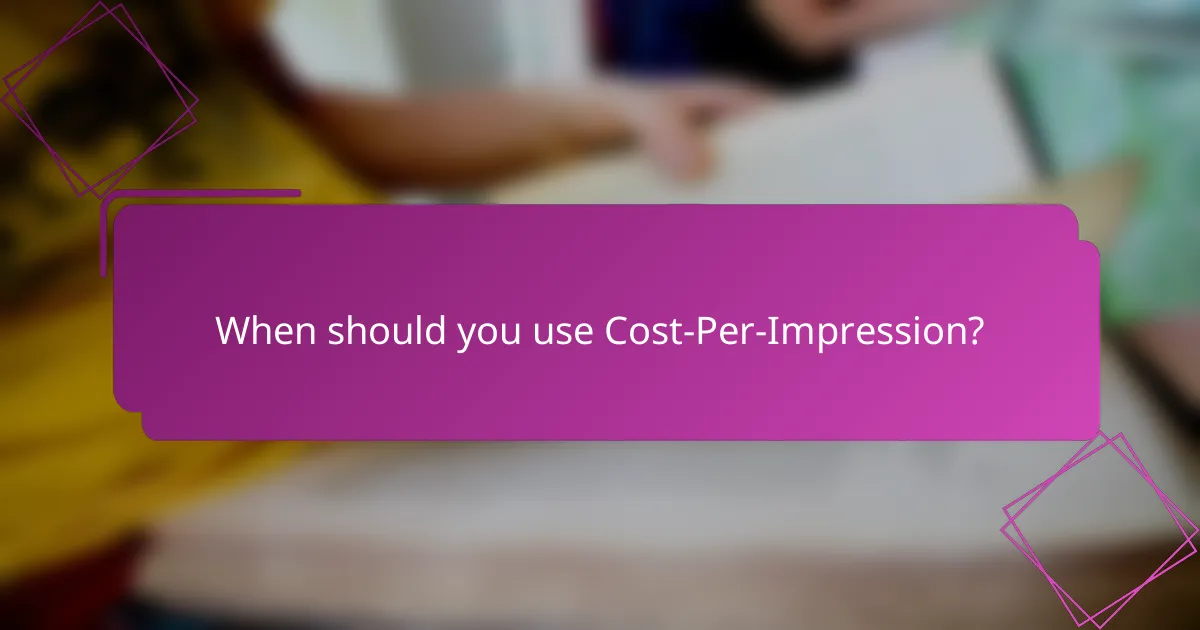
When should you use Cost-Per-Impression?
Cost-Per-Impression (CPI) is best utilized when brand visibility is the primary goal, rather than immediate conversions. This pricing model allows advertisers to pay for ad placements based on the number of times their ad is displayed, making it suitable for campaigns focused on awareness and reach.
Best scenarios for CPI usage
CPI is ideal for campaigns aimed at building brand recognition or promoting new products. For instance, if a company is launching a new beverage, using CPI can help ensure that the ad is seen by a large audience, even if it doesn’t lead to immediate sales. Additionally, CPI works well for display ads on websites with high traffic, where impressions can accumulate quickly.
Another scenario is when targeting a broad audience across various platforms. In such cases, advertisers can maximize exposure and gather valuable data on audience engagement without the pressure of immediate clicks or conversions.
Target audience considerations for CPI
When using CPI, understanding the target audience is crucial. Advertisers should focus on demographics that align with their brand values and messaging. For example, a luxury brand may want to target affluent consumers through high-end lifestyle websites, ensuring that the impressions are valuable and relevant.
Moreover, consider the platforms where the target audience spends their time. If the audience is predominantly on social media, using CPI on those platforms can enhance visibility. However, it’s essential to monitor engagement metrics to ensure that impressions translate into meaningful interactions, rather than just passive views.

How do CPC and CPI compare?
CPC (Cost-Per-Click) and CPI (Cost-Per-Impression) are two distinct pricing models used in online advertising. CPC charges advertisers each time a user clicks on their ad, while CPI charges based on the number of times the ad is displayed, regardless of user interaction.
Key differences between CPC and CPI
The primary difference between CPC and CPI lies in how advertisers are billed. With CPC, costs are incurred only when a user engages with the ad, making it ideal for campaigns focused on driving traffic. In contrast, CPI generates costs based on impressions, which can be beneficial for brand awareness campaigns aiming to reach a larger audience.
Another key difference is the level of risk involved. CPC can be more cost-effective for performance-driven campaigns, while CPI may lead to higher costs if the ad does not convert effectively, as advertisers pay for visibility rather than engagement.
Advantages and disadvantages of CPC
CPC offers the advantage of paying only for actual user interactions, which can lead to a higher return on investment (ROI) for campaigns focused on conversions. Advertisers can closely monitor performance and adjust bids based on the effectiveness of their ads.
However, the downside of CPC is that it can lead to fluctuating costs depending on competition for keywords. Advertisers may also face challenges in managing click fraud, where bots or competitors generate false clicks, increasing costs without delivering real value.
Advantages and disadvantages of CPI
The main advantage of CPI is that it allows advertisers to maximize visibility and brand exposure, making it suitable for campaigns aimed at generating awareness. This model can be particularly effective for new product launches or when entering new markets.

What are the pricing models for display advertising?
Display advertising primarily utilizes two pricing models: Cost-Per-Click (CPC) and Cost-Per-Impression (CPM). Each model serves different advertising goals and can significantly impact campaign performance and budgeting.
Overview of pricing models
Cost-Per-Click (CPC) charges advertisers each time a user clicks on their ad, making it ideal for campaigns focused on driving traffic and conversions. In contrast, Cost-Per-Impression (CPM) charges advertisers for every thousand impressions their ad receives, which is better suited for brand awareness and visibility.
Advertisers often choose between these models based on their objectives. For instance, if the goal is to generate leads, CPC may be more effective, while CPM can be advantageous for campaigns aimed at maximizing reach.
Factors influencing pricing decisions
Several factors influence the choice between CPC and CPM. The target audience, campaign goals, and the nature of the product or service play crucial roles. For example, niche markets may benefit from CPC due to higher engagement rates, while broader campaigns might find CPM more cost-effective.
Additionally, the competitive landscape can impact pricing. In highly competitive sectors, CPC rates may rise, prompting advertisers to consider CPM for better budget management. Understanding these dynamics helps in making informed decisions that align with marketing objectives.
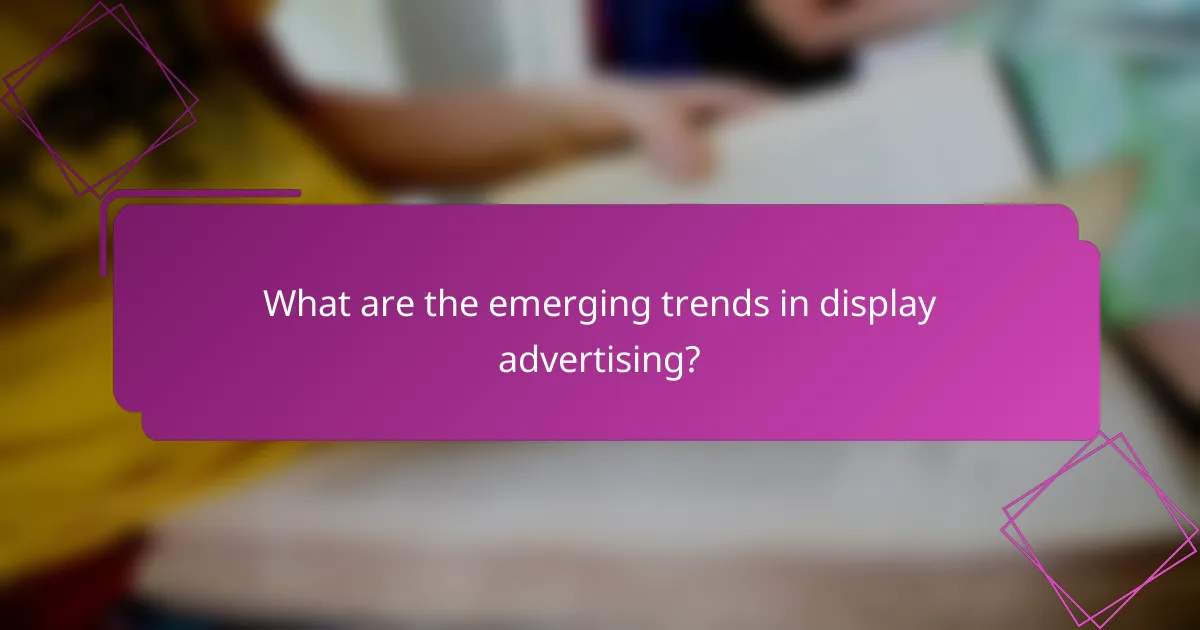
What are the emerging trends in display advertising?
Emerging trends in display advertising include the increasing use of artificial intelligence (AI) for targeting and optimization, as well as a shift towards more personalized ad experiences. Advertisers are focusing on data-driven strategies to enhance engagement and conversion rates while adapting to evolving consumer preferences.
Impact of AI on CPC and CPI
AI is significantly transforming both Cost-Per-Click (CPC) and Cost-Per-Impression (CPI) models in display advertising. By leveraging machine learning algorithms, advertisers can optimize their bidding strategies in real-time, ensuring they pay the most competitive rates while maximizing ad visibility and engagement.
For CPC, AI can analyze user behavior and predict which clicks are more likely to convert, allowing advertisers to allocate budgets more effectively. In contrast, for CPI, AI helps in identifying the best placements and times to show ads, increasing impressions while maintaining cost efficiency.
To maximize the benefits of AI in your advertising strategy, consider testing different bidding strategies and continuously monitoring performance metrics. Avoid relying solely on historical data; instead, embrace AI’s predictive capabilities to stay ahead of market trends and consumer behavior shifts.
